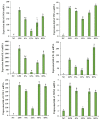The Effect of N-Acetylation on the Anti-Inflammatory Activity of Chitooligosaccharides and Its Potential for Relieving Endotoxemia
- PMID: 35897781
- PMCID: PMC9330575
- DOI: 10.3390/ijms23158205
The Effect of N-Acetylation on the Anti-Inflammatory Activity of Chitooligosaccharides and Its Potential for Relieving Endotoxemia
Abstract
Endotoxemia is mainly caused by a massive burst of inflammatory cytokines as a result of lipopolysaccharide (LPS) invasion. Chitooligosaccharides (COS) is expected to be a potential drug for relieving endotoxemia due to its anti-inflammatory properties. However, the structural parameters of COS are often ambiguous, and the effect of degree of acetylation (DA) of COS on its anti-inflammatory remains unknown. In this study, four COSs with different DAs (0%, 12%, 50% and 85%) and the same oligomers distribution were successfully obtained. Their structures were confirmed by 1H NMR and MS analysis. Then, the effect of DA on the anti-inflammatory activity and relieving endotoxemia potential of COS was researched. The results revealed that COS with a DA of 12% had better anti-inflammatory activity than COSs with other DAs, mainly in inhibiting LPS-induced inflammatory cytokines burst, down-regulating its mRNA expression and reducing phosphorylation of IκBα. Furthermore, this COS showed an obviously protective effect on endotoxemia mice, such as inhibiting the increase in inflammatory cytokines and transaminases, alleviating the injury of liver and intestinal tissue. This study explored the effect of DA on the anti-inflammatory activity of COS for the first time and lays the foundation for the development of COS as an anti-inflammatory drug against endotoxemia.
Keywords: anti-inflammation; chitooligosaccharides; degree of acetylation; endotoxemia.
Conflict of interest statement
The authors declare no conflict of interest.
Figures










Similar articles
-
Green-Chemical Strategies for Production of Tailor-Made Chitooligosaccharides with Enhanced Biological Activities.Molecules. 2023 Sep 13;28(18):6591. doi: 10.3390/molecules28186591. Molecules. 2023. PMID: 37764367 Free PMC article. Review.
-
Immunomodulatory activity of single chitooligosaccharides in LPS-induced RAW264.7 cells and endotoxemia mice.Carbohydr Res. 2025 Jul;553:109523. doi: 10.1016/j.carres.2025.109523. Epub 2025 May 9. Carbohydr Res. 2025. PMID: 40359661
-
Impact of O-acetylation on chitin oligosaccharides modulating inflammatory responses in LPS-induced RAW264.7 cells and mice.Carbohydr Res. 2024 Aug;542:109177. doi: 10.1016/j.carres.2024.109177. Epub 2024 Jun 6. Carbohydr Res. 2024. PMID: 38880715
-
The water extract of "Jiao Mei Gu" attenuates the lipopolysaccharide-induced inflammatory response via inhibiting NF-κB activity in mice.J Ethnopharmacol. 2020 Sep 15;259:112882. doi: 10.1016/j.jep.2020.112882. Epub 2020 Apr 20. J Ethnopharmacol. 2020. PMID: 32325181
-
The preparation, modification and hepatoprotective activity of chitooligosaccharides: A review.Int J Biol Macromol. 2024 Oct;277(Pt 3):134489. doi: 10.1016/j.ijbiomac.2024.134489. Epub 2024 Aug 5. Int J Biol Macromol. 2024. PMID: 39111493 Review.
Cited by
-
Green-Chemical Strategies for Production of Tailor-Made Chitooligosaccharides with Enhanced Biological Activities.Molecules. 2023 Sep 13;28(18):6591. doi: 10.3390/molecules28186591. Molecules. 2023. PMID: 37764367 Free PMC article. Review.
-
Comparison of the protective effects of chitosan oligosaccharides and chitin oligosaccharide on apoptosis, inflammation and oxidative stress.Exp Ther Med. 2024 Jun 5;28(2):310. doi: 10.3892/etm.2024.12600. eCollection 2024 Aug. Exp Ther Med. 2024. PMID: 38873041 Free PMC article.
-
Effect of Chitooligosaccharides on TLR2/NF-κB Signaling in LPS-Stimulated RAW 264.7 Macrophages.Molecules. 2025 May 20;30(10):2226. doi: 10.3390/molecules30102226. Molecules. 2025. PMID: 40430398 Free PMC article.
-
Pleiotropic Modulation of Chitooligosaccharides on Inflammatory Signaling in LPS-Induced Macrophages.Polymers (Basel). 2023 Mar 23;15(7):1613. doi: 10.3390/polym15071613. Polymers (Basel). 2023. PMID: 37050227 Free PMC article.
References
MeSH terms
Substances
Grants and funding
LinkOut - more resources
Full Text Sources

